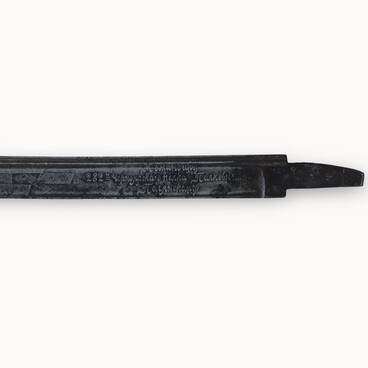Zlatoust is known largely for a unique type of arts and crafts — Zlatoust steel engraving. The origin of this distinctive art was associated with the activities of the weapons factory, the manufacture of “decorated” weapons, which were intended for high-ranking officials of the state, honored military commanders, and foreign guests of the imperial court.
One of the best works of Zlatoust engravers is a cavalry officer’s saber of the 1807/1819 model. The blade was decorated by Ivan Nikolayevich Bushuyev, the senior craftsman of the decoration department of the Zlatoust Arms Factory. The artistic decoration of the blade was made using the techniques of etching, bluing, and gilding.
The curved saber blade with two grooves and a “yelman” — an extension towards the end of the saber strip — was complemented by a hilt with a cast bronze, gilded three-bow guard. The wooden handle was covered with leather and wrapped in twisted wire.
On one side, the saber blade was decorated with a miniature depicting an episode from the Patriotic War of 1812. In the foreground are dead and wounded soldiers, the background shows a fierce battle: in clouds of smoke are two ranks of soldiers firing guns. On the left, there are officers on horseback. To the right and left of the main composition, surrounded by floral ornaments in geometric windows, are images of a griffin and a winged horse. The winged horse in flight — a kind of the famous master’s trademark brand — eventually became a symbol of the Zlatoust craftsmanship and took its honorable place on the city’s coat of arms.
The reverse side was engraved with a composition of a double-headed eagle (as the imperial coat of arms), cannon barrels, spears, sabers, and banners. The frame was made in the form of an elegant antique ornament with geometric windows on the sides, which featured images of a griffin and a winged horse.
The butt bears the factory mark “Zlatoust 1823” and the designer’s brand — an autograph of Ivan Bushuyev. He was a well-known miniaturist, who commonly depicted multi-figured battle compositions on blades.
One of the best works of Zlatoust engravers is a cavalry officer’s saber of the 1807/1819 model. The blade was decorated by Ivan Nikolayevich Bushuyev, the senior craftsman of the decoration department of the Zlatoust Arms Factory. The artistic decoration of the blade was made using the techniques of etching, bluing, and gilding.
The curved saber blade with two grooves and a “yelman” — an extension towards the end of the saber strip — was complemented by a hilt with a cast bronze, gilded three-bow guard. The wooden handle was covered with leather and wrapped in twisted wire.
On one side, the saber blade was decorated with a miniature depicting an episode from the Patriotic War of 1812. In the foreground are dead and wounded soldiers, the background shows a fierce battle: in clouds of smoke are two ranks of soldiers firing guns. On the left, there are officers on horseback. To the right and left of the main composition, surrounded by floral ornaments in geometric windows, are images of a griffin and a winged horse. The winged horse in flight — a kind of the famous master’s trademark brand — eventually became a symbol of the Zlatoust craftsmanship and took its honorable place on the city’s coat of arms.
The reverse side was engraved with a composition of a double-headed eagle (as the imperial coat of arms), cannon barrels, spears, sabers, and banners. The frame was made in the form of an elegant antique ornament with geometric windows on the sides, which featured images of a griffin and a winged horse.
The butt bears the factory mark “Zlatoust 1823” and the designer’s brand — an autograph of Ivan Bushuyev. He was a well-known miniaturist, who commonly depicted multi-figured battle compositions on blades.







